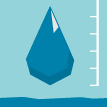State
Trend
Sample history at this site
What is this graph showing me?
This graph is displaying chloride concentrations over the selected time period. You can adjust this period by changing the dropdowns. These records form the basis for the state and trend indicators displayed on the dashboard. Find out how state and trend are calculated.
You can hover over the top of bars to see the sample dates and values. Yellow coloured bars on the graph represent measured values. Grey coloured bars represent concentrations that were either below or above the detection limit for the lab method used (detection limit details are not currently able to be viewed for Auckland, Otago or Waikato regions).
You can also compare the measured values to the Drinking-water Standards for New Zealand (DWSNZ) benchmark. The guideline value for chloride concentrations in drinking water is 250 mg/L. Concentrations above this may affect the taste of the water.
Water quality can change with groundwater levels. For some well sites the groundwater level (taken at the same time as the water quality sample) is also available to view.
Monitoring data displaying from the current year (2024) may not have gone through council quality assurance processes and should be treated as unverified.
State
Trend
Sample history at this site
What is this graph showing me?
This graph is displaying dissolved reactive phosphorus concentrations over the selected time period. You can adjust this period by changing the dropdowns. These records form the basis for the state and trend indicators displayed on the dashboard. Find out how state and trend are calculated.
You can hover over the top of bars to see the sample dates and values. Yellow coloured bars on the graph represent measured values. Grey coloured bars represent concentrations that were either below or above the detection limit for the lab method used (detection limit details are not currently able to be viewed for Auckland, Otago or Waikato regions).
Water quality can change with groundwater levels. For some well sites the groundwater level (taken at the same time as the water quality sample) is also available to view.
Monitoring data displaying from the current year (2024) may not have gone through council quality assurance processes and should be treated as unverified.
State
Trend
Sample history at this site
What is this graph showing me?
This graph is displaying E. coli concentrations over the selected time period. You can adjust this period by changing the dropdowns. These records form the basis for the state and trend indicators displayed on the dashboard. Find out how state and trend are calculated.
You can hover over the top of bars to see the sample dates and values. Yellow coloured bars on the graph represent measured values. Grey coloured bars represent concentrations that were either below or above the detection limit for the lab method used (detection limit details are not currently able to be viewed for Auckland, Otago or Waikato regions).
You can also compare the measured values to the Drinking-water Standards for New Zealand (DWSNZ) benchmark. E. coli must not be detected in a 100 mL sample of drinking water (the test result must be <1 CFU/100 mL). If E. coli is detected, the water must be treated to ensure it is safe for human consumption.
Water quality can change with groundwater levels. For some well sites the groundwater level (taken at the same time as the water quality sample) is also available to view.
Monitoring data displaying from the current year (2024) may not have gone through council quality assurance processes and should be treated as unverified.
State
Trend
Sample history at this site
What is this graph showing me?
This graph is displaying electrical conductivity over the selected time period. You can adjust this period by changing the dropdowns. These records form the basis for the state and trend indicators displayed on the dashboard. Find out how state and trend are calculated.
You can hover over the top of bars to see the sample dates and measured values.
Water quality can change with groundwater levels. For some well sites the groundwater level (taken at the same time as the water quality sample) is also available to view.
Monitoring data displaying from the current year (2024) may not have gone through council quality assurance processes and should be treated as unverified.
State
Trend
Sample history at this site
What is this graph showing me?
This graph is displaying nitrate nitrogen concentrations over the selected time period. You can adjust this period by changing the dropdowns. These records form the basis for the state and trend indicators displayed on the dashboard. Find out how state and trend are calculated.
You can hover over the top of bars to see the sample dates and values. Yellow coloured bars on the graph represent measured values. Grey coloured bars represent concentrations that were either below or above the detection limit for the lab method used (detection limit details are not currently able to be viewed for Auckland, Otago or Waikato regions).
You can also compare the measured values to the Drinking-water Standards for New Zealand (DWSNZ) benchmark. The maximum acceptable value for nitrate nitrogen is 11.3 mg/L. Concentrations above this can pose a health risk to bottle-fed infants.
Water quality can change with groundwater levels. For some well sites the groundwater level (taken at the same time as the water quality sample) is also available to view.
Monitoring data displaying from the current year (2024) may not have gone through council quality assurance processes and should be treated as unverified.

